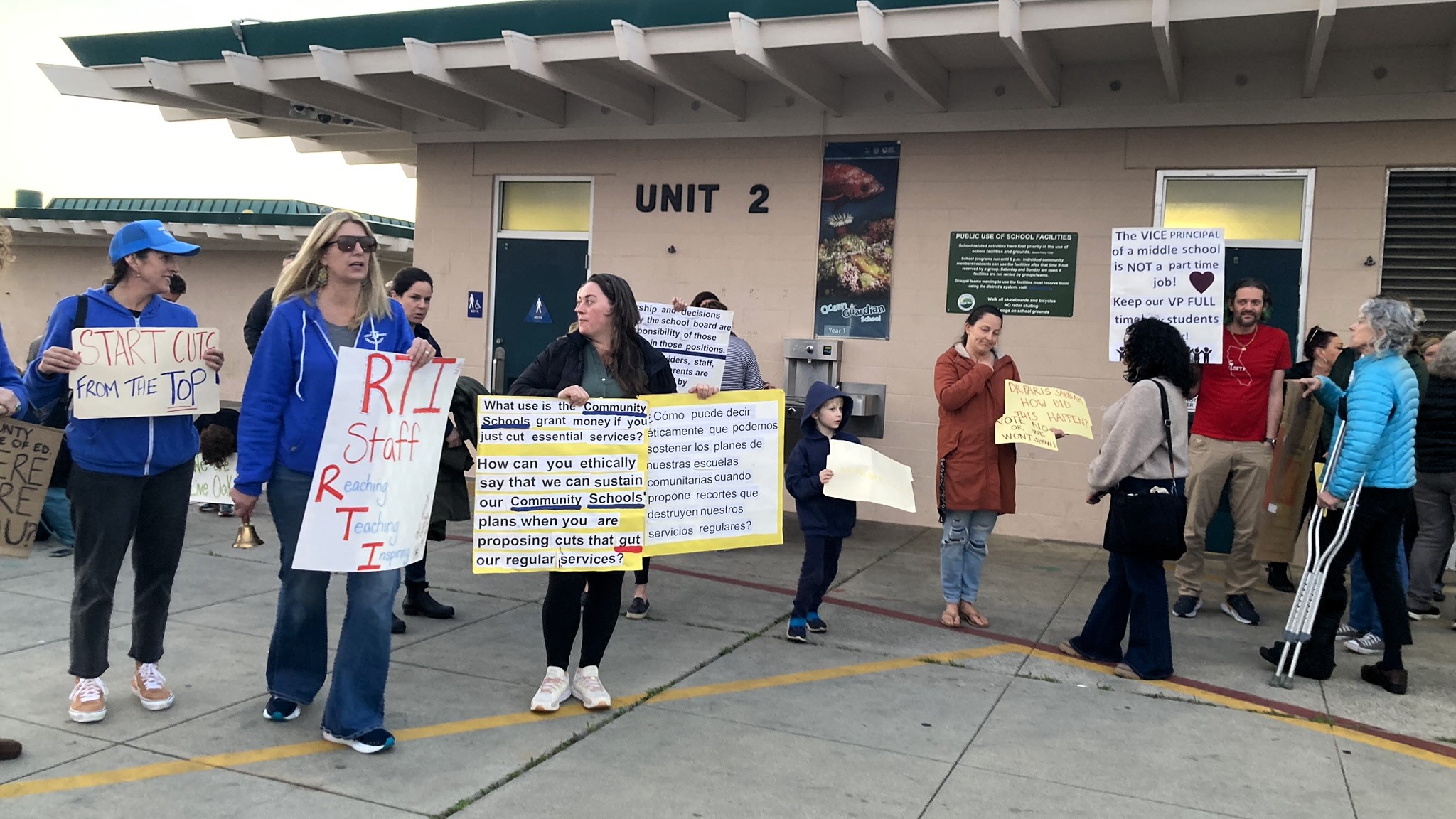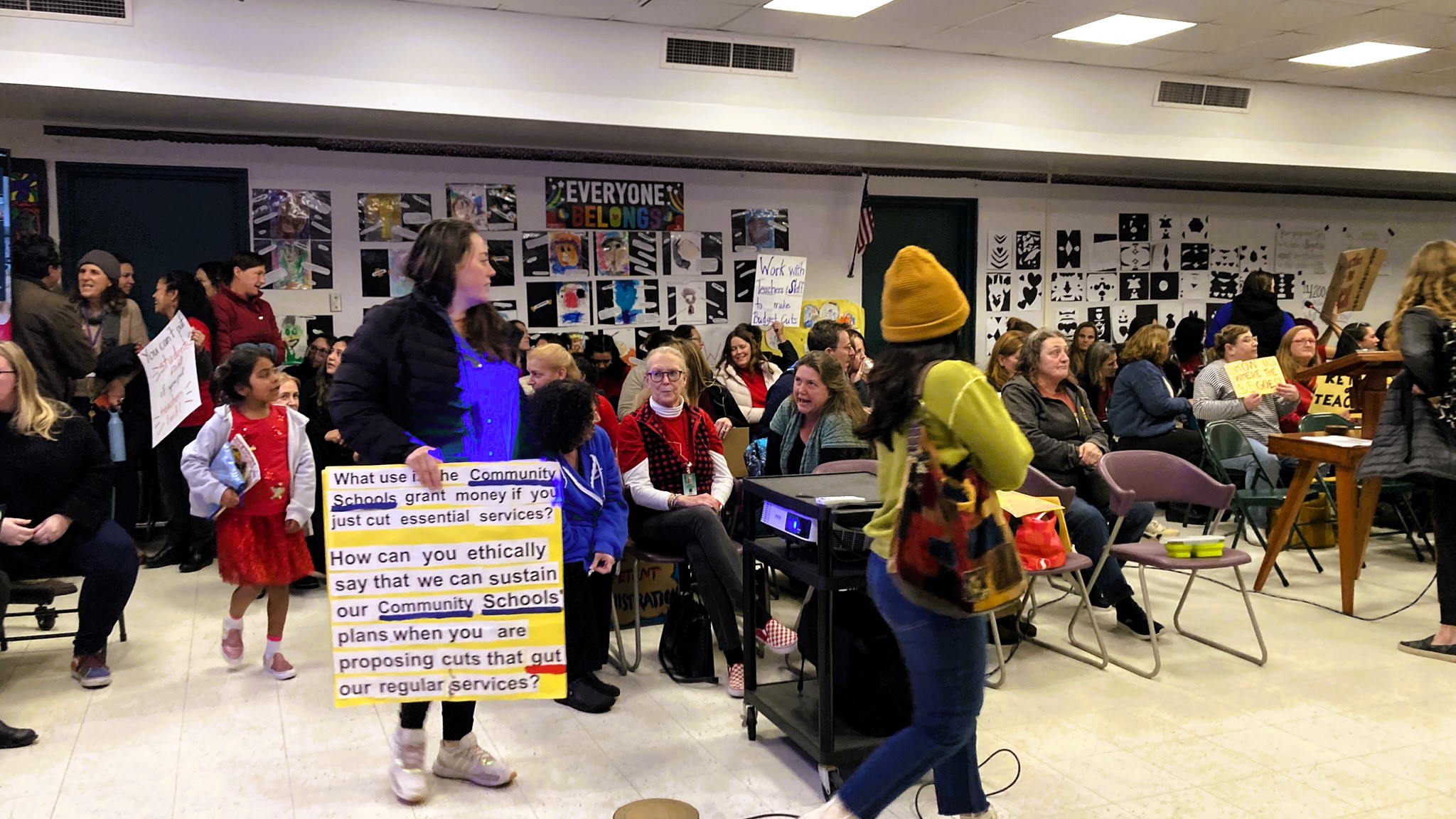
Parents, students and staff protest proposed layoffs outside a Feb. 21 Live Oak School Board meeting. (Jesse Kathan — Santa Cruz Local)
Read Santa Cruz Local's Election Guide
Editor’s note: The location of the Feb. 27 Live Oak School Board meeting has been updated in this story.
LIVE OAK >> Plans to close a $2.9 million budget gap and save the Live Oak School District from a state takeover stalled during a Feb. 21 school board meeting, as some parents and staff said school district administrators should be laid off rather than teachers.
More than 150 parents, students and staff crowded the Green Acres Elementary School multi-purpose room for the meeting. Live Oak School Board trustees unveiled a draft plan that proposed layoffs for 36 of the district’s 221 full-time equivalent employees.
Some of the proposed cuts are for part-time positions, so more than 36 employees would be laid off or have hours cut. The proposed cuts included:
- The equivalent of 13.45 full-time teachers, including seven elementary school teachers.
- The equivalent of 4.5 full-time math and reading aides.
- The equivalent of 2.4 full-time special education aides.
- A director of family and community engagement and a community schools program coordinator.
- An alternative education principal, an elementary school principal, and a vice principal would be reduced to half-time. Shoreline Middle School Vice Principal Melissa Nix would remain a full-time employee and use part of her hours at another position, trustees said.
Live Oak School District’s General Fund budget was $29.3 million in Fiscal Year 2022-2023. The district took in $27.3 million in revenue, so it continued to tap into its reserves.
School district trustees did not vote on a proposed plan to approve layoffs at Wednesday’s meeting. At the next school board meeting at 6 p.m. Feb. 27 at Live Oak Elementary School, the trustees plan to present another proposal with a wider range of layoff notices that include some district office staff, Live Oak School Board President Kristin Pfotenhauer said in an interview.
“Then we will be fine-tuning the decision — what the actual cuts are — afterwards just because we don’t have time,” Pfotenhauer said. Legally, anyone who may be laid off must be notified by March 15. Parents and community members can give feedback on potential cuts at a separate forum Feb. 29, she said. The Feb. 29 meeting’s time and location has not been finalized.
Money problems
In January, the Santa Cruz County Board of Education sent a letter to the trustees that stated that Live Oak School District likely cannot pay its expenses for the new fiscal year that starts July 1. The letter required the school board to create a plan to stabilize the district’s finances by March 15.
Without a county-approved financial plan, the district likely would be “fiscally insolvent” and the California Board of Education would appoint an advisor to take over financial planning for the school district. The advisor would have wide latitude to reduce hours or make layoffs.
At Wednesday’s meeting, Live Oak School Board trustee Jeremy Ray said he received many emails that called out a “lack of leadership in the district.” Some emails said the trustees should have anticipated the need for budget cuts.
“I just want to say that that’s all true,” Ray said. He said the board whittled away at declining reserves by approving multiple raises for teachers and staff over the last 10 years.
The proposed cuts were designed to be equitable between administrators, staff without credentials and teachers and other staff with educational credentials, said Hanwool Kim, assistant superintendent of business services. They include:
- 17% of the district’s full-time-equivalent management staff.
- 15% of non-management “certificated” staff with a teaching or health-related credential.
- 18% of non-management “classified” staff without a credential.
- 14% of classified and certificated staff who work with confidential information.
However, spending on teachers’ salaries is already 5% lower than six years ago, according to school district budget documents. In the past six years, spending increased on classified staff, supervisors, administrators and staff with certificates.
For example, salaries for office staff in the Fiscal Year 2023-2024 budget are 75% higher than in the Fiscal Year 2018-2019 budget. Salaries for classified instructional staff, which includes reading and math aides, increased by nearly 70%.
Pfotenhauer, the school board president, said the district is spending less on teacher salaries because declining enrollment has led the district to hire fewer teachers.
She added that all classified staff have had raises, and that starting wages for some positions were outpaced by increases in minimum wage. Many other positions have been funded by grants and other money restricted for specific uses, she said.
The district spent $8.1 million on teacher salaries in Fiscal Year 2018-2019 and budgeted $7.9 million for the current fiscal year. Those totals include the unrestricted General Fund, which can be used for any purpose, and funds that can only be used for specific expenses, like the Child Development Fund.
Declining enrollment
School district leaders said budget problems also stemmed from lower enrollment, lower attendance and lower than expected state funding. The state’s school funding formulas are based in part on enrollment and attendance.
Live Oak School District Superintendent Daisy Morales said the planned cuts to teachers were necessary, and that current class sizes are smaller than limits negotiated in teachers’ contracts. “We can’t have classrooms of less than 19 or 20,” she said. “The state does not give us the money to be able to have tiny little classrooms.”
Most of the one-time grant money has been spent, and the district doesn’t have enough in reserves to continue funding many positions. Morales said the cuts were a consequence of using the one-time grants to their fullest extent.
“We invested the majority of our COVID money in people,” Morales said. “We wanted to keep the services intact as long as we possibly have the money to do it.” She added, “I am heartbroken that we have to let go of all of these positions. That’s the last thing we want to do. And yet we are bound by the constringencies of funding.”
Less money for teachers is due in part to declining enrollment, Pfotenhauer said. With fewer students, schools need fewer teachers, she said. Average daily attendance has decreased 12% since the 2017-2018 school year, according to budget documents.

Parents, students and staff protest proposed layoffs at a Feb. 21 Live Oak School Board meeting. (Jesse Kathan — Santa Cruz Local)
In the past few years, the district has also seen higher than expected special education costs, Kim said.
The district has also kept a low reserve fund, which means it can no longer weather years where spending outpaces revenues. During the past five years, the reserve has hovered between 3% and 6% of the budget. The state requires a reserve of at least 3% of Live Oak’s budget.
The 2023-2024 budget approved in June 2023 planned to boost reserves to nearly 9% of the General Fund. But those reserves won’t be enough to carry the district through the next year without cuts, according to the letter from the county board of education.
Live Oak School District received millions of dollars in one-time state and federal grants at the beginning of the COVID-19 pandemic. It also recently benefited from unusually generous state funding, Kim said. That money was meant to cushion the loss of one-time funding and preserve existing staff.
“That’s not necessarily how it was used at this district,” he said. “Live Oak School District needs to develop a mindset of saving money and building up reserves. A healthy reserve would be about 10% to 12%.”
Pushback against budget cuts
At Wednesday’s meeting, more than a dozen parents, staff and community members pushed back against the proposed cuts. Many suggested cutting more administrative positions in the district office that don’t work directly with students.
“Do not make the community pay the price for poor management of funds,” said Sheila McNeese, a parent in the school district.
At the school board’s Feb. 7 meeting, trustees approved a 5% raise for superintendent Daisy Morales and assistant superintendents. Parents and district staff said they were baffled about the prior vote, especially since the county had already mandated a financial stabilization plan. At Wednesday’s meeting, the board announced that the superintendent and assistant superintendents would voluntarily forego that raise.
“Two weeks ago, we’re talking about major cuts and you guys vote yes to giving her a pay increase,” said parent Serena Potter at the Feb. 21 meeting. “Shocking, surprising, disheartening, confusing.”
The district must approve a plan and send notifications of layoffs by March 15, trustees said.
“I just want to make it clear that we can’t solve this problem and keep all of the employees that we have unless there are major concessions made that I don’t think are going to be made,” said Ray. “If the district goes financially insolvent, then the district goes financially insolvent. I just want to make sure that people understand what you’re asking for when you’re asking us not to take action.”
Under state supervision, the district would receive a loan to address the immediate crisis, but would be required to pay it back with 7% interest, Pfotenhauer said. “Suddenly you end up in a situation where you have to make much harder cuts,” she said. “And you can end up stuck in that for a while.”
Live Oak Senior Center
Several people at Wednesday’s meeting said the board should consider filling the budget gap by selling 1777 Capitola Road, a district-owned property that houses the Live Oak Senior Center. The district has long considered building housing for teachers on the site. Meals on Wheels of Santa Cruz County, a program of Community Bridges, has submitted a letter of intent to purchase the property for $2.4 million.
Ray said during the meeting that they may sell the property in the future, but that calls to accept the offer don’t “put us in a position of negotiating from strength.” State law does not allow the proceeds from property sales to pay for staff salaries, said Kim, the associate superintendent.
Katie Gilpin, a fourth grade teacher at Green Acres Elementary, asked the board to consider merging with another school district such as Soquel Union Elementary School District.
“We have kids to serve that are going down in numbers, but we have to have a district office, we have to have [human resources], we have to have accountants,” she said. “It just seems like a solution you kind of have to head towards in the near future no matter what, because we have these tiny schools that are just getting smaller.”
Ray and Pfotenhauer agreed that the board should consider merging with another district in the future. Consolidating districts is “a long and complicated process and one that will not solve our current problem,” Pfotenhauer said.
Questions or comments? Email [email protected]. Santa Cruz Local is supported by members, major donors, sponsors and grants for the general support of our newsroom. Our news judgments are made independently and not on the basis of donor support. Learn more about Santa Cruz Local and how we are funded.
Jesse Kathan is a staff reporter for Santa Cruz Local through the California Local News Fellowship. Kathan holds a master's degree in science communications from UC Santa Cruz.





